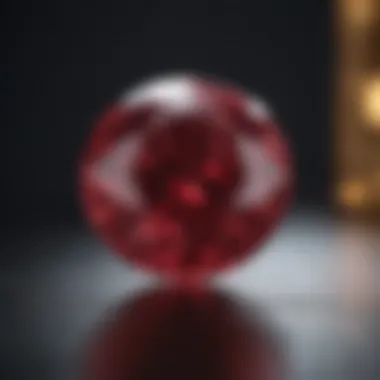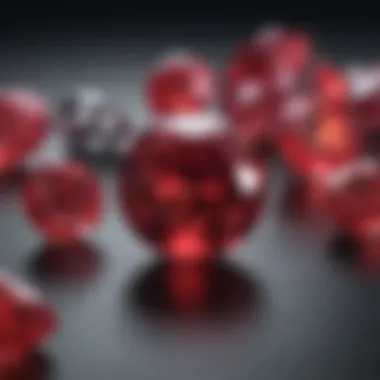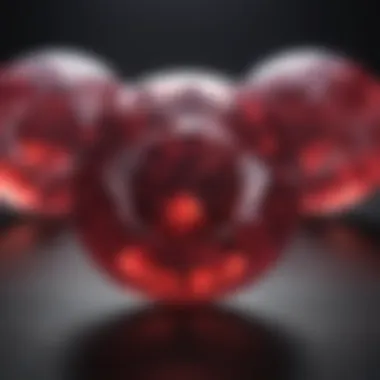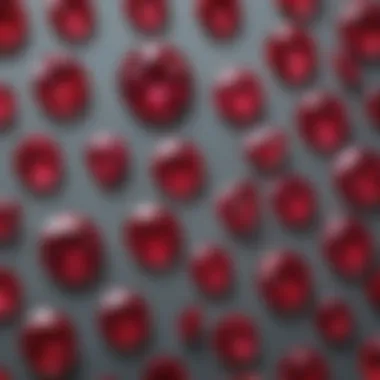Understanding the Dimensions of a 1 Carat Ruby


Intro
Gemstone Overview
Definition of Gemstones
Gemstones are precious or semi-precious stones that are cut and polished for use in jewelry. They are typically classified by their rarity, beauty, and durability. Rubies, known for their deep red hue, belong to the corundum mineral family. They are valued not only for their color but also for their clarity and size. Other gemstones include sapphires, emeralds, and diamonds, each with distinct characteristics that determine their appeal and worth.
Classification of Gemstones
Gemstones can be broadly classified into two categories: precious and semi-precious. Precious gemstones include diamonds, sapphires, rubies, and emeralds. These stones are considered more valuable due to their rarity and the quality of their appearance. Semi-precious gemstones encompass a wider range of stones like amethyst, garnet, and citrine. Each type has its particular metrics for assessment, including carat weight, cut, clarity, and color, which all contribute to the gemstone's final value and desirability.
Historical Significance
Origins of Gemstone Use
The use of gemstones dates back thousands of years. Ancient civilizations valued them for their beauty and believed in their metaphysical properties. Rubies were especially prized by royalty. They were thought to bring good fortune and protection in battle. Understanding the historical context enhances our appreciation of rubies today.
Cultural Insights: Gemstones in Ancient Civilizations
In ancient cultures, gemstones held significant cultural importance. For instance, in India, rubies have been used in jewelry for centuries, often associated with wealthy classes. In the ancient Greeks, rubies symbolized love and passion, leading to their use in wedding rings and other romantic gifts. The significance of rubies extends beyond mere decoration; they are imbued with meaning and tradition across different cultures.
"Rubies, a symbol of power and passion, have transcended cultural boundaries for centuries."
Preamble to Ruby Measurements
When discussing gemstones, particularly rubies, understanding the measurements is fundamental. This section serves to illuminate the significance of measurements and their implications for both collectors and enthusiasts. Each dimension, from carat weight to physical size, influences how rubies are valued and perceived in the market.
Ruby measurements are not merely numerical values; they reflect the gem’s quality, rarity, and overall aesthetic appeal. A 1 carat ruby might seem straightforward, but its actual dimensions can vary significantly based on factors like cut and shape. This variation makes it crucial for buyers to comprehend what these measurements mean when assessing rubies for jewelry or collection purposes.
Benefits of Understanding Ruby Measurements
- Informed Decisions: Knowledge of ruby measurements allows buyers to make informed choices, whether for personal wear or investment.
- Value Appreciation: Understanding how measurements relate to quality can aid collectors in recognizing and purchasing high-value pieces.
- Quality Assessment: Measuring a ruby accurately can reveal potential flaws or strengths, leading buyers to prioritize their purchases based on solid criteria.
Key Considerations
- Different cuts can yield different perceptions of size. A well-cut ruby may appear larger than a poorly cut counterpart, despite having the same carat weight.
- Color and clarity also play roles, affecting how the size is perceived visually.
- Measurements may differ across regions and standards, making it essential to familiarize oneself with local practices.
By grasping these measurement dimensions, enthusiasts and collectors can navigate the ruby market more effectively, ensuring their selections reflect both beauty and worth.
Defining Carat Weight
Carat weight is one of the essential metrics used in the gemstone industry. Understanding this concept is crucial for anyone interested in rubies or gemstones in general. Carat weight not only influences the value of a ruby but also its perceived size and presence in jewelry. Each carat is defined as 200 milligrams, providing a standard for weight measurement across various gemstones. This section will delve into the historical context and the standard measurements that define the carat weight, enriching your comprehension of its significance.
Historical Context of Carat
The term "carat" has its roots in the carob seeds used as balances in ancient trading. These seeds were remarkably consistent in weight, making them an ideal reference point for weighing precious stones. The carat system became more formalized in the 14th century, with specific weight standards being adopted to ensure more uniformity in the gemstone trade.
Over time, the adoption of standardized weights paved the way for improved appraisal and evaluation of gemstones. In 1907, the International Carat was established, standardizing the carat as 200 milligrams globally. This historical evolution underscores the essential nature of carat weight in determining both the economic and aesthetic value of rubies today.


Standard Measurements in Gemstones
In the realm of gemstones, measurement standards extend beyond just carat weight. These measurements can influence perceptions about size and value. Here are some standard measurements commonly used in the industry:
- Carat Weight: The most recognized unit, indicating the weight of the gem. Larger carat weights generally command higher prices.
- Millimeter Measurements: Dimensions such as width, length, and depth are measured in millimeters, providing a more accurate depiction of a gem’s size.
- Gemstone Shape: The cut and shape of the gemstone impact how size is perceived. For instance, a round cut may appear larger than a cushion cut, even at the same carat weight.
Understanding these measurements is critical when evaluating rubies, as they directly affect market value and personal preference.
By comprehending the standards surrounding carat weight and its historical emergence, you gain valuable insights into the significance of this metric in the world of rubies. As you navigate your journey through gemstone appreciation, these foundations of carat weight will serve you well.
Physical Size of a Carat Ruby
The physical size of a 1 carat ruby is a critical aspect for anyone interested in gemstones, particularly for collectors and jewelry designers. Understanding the actual dimensions of a ruby that has a carat weight of one is essential for making informed decisions regarding purchases and settings. Physical size impacts not just aesthetics but also the overall perception of size. It influences how the gemstone will appear in jewelry pieces, potentially affecting market value as well. This section will elucidate various components that delineate the physical size, emphasizing their importance in the context of rubies.
Understanding Dimensions
When discussing the dimensions of a 1 carat ruby, one must consider that carat weight does not unilaterally dictate size. A carat is a measurement of weight and not size. Various gems of the same carat weight can exhibit different dimensions based on their specific cut, depth, and overall shape.
In general, a well-cut ruby of approximately one carat will measure about 6.5 mm in diameter if it is round. However, the shape can vary significantly. For example, a cushion cut ruby could measure around 5.5 x 5.5 mm. The geometry significantly influences how the ruby is perceived both in isolation and within its setting.
Moreover, understanding dimensions includes recognizing the impact of depth in the stone. A ruby that is cut too shallow or too deep will not display light effectively, thereby altering its visual size and perceived quality. An ideal depth typically falls within a range that maximizes brilliance while maintaining a visually appealing size.
Carat Weight vs. Size Perception
Carat weight often creates misconceptions regarding the physical size of a ruby. Many buyers equate higher carat weights simply with larger sizes, but this can lead to misunderstandings. For instance, two one-carat rubies may look different when one is cut poorly and the other is cut with precision. The one with superior craftsmanship will often appear larger and more radiant.
Another aspect of size perception involves the surrounding context. A ruby set in an intricate design may look smaller than it truly is, relative to other gems in the same piece. The frame, metal, and accompanying stones impact viewer perception significantly. It is common to see comparisons of rubies side by side with other stones, which further complicates size perception.
- Key Factors Affecting Size Perception:
- Cut Quality: Determines how light interacts with the ruby.
- Setting Design: Shapes surrounding the ruby influence visual appearance.
- Colour and Clarity: A deep, vivid color can draw attention despite size.
"Understanding the nuances of physical size versus carat weight can empower enthusiasts to appreciate rubies on a deeper level."
In summary, the physical size of a 1 carat ruby encompasses various dimensions that are essential for comprehending how a ruby will present itself in direct comparison to its carat weight. Both dimensions and how they are perceived in real-world applications are critical for anyone engaging with ruby stones, whether for investment or aesthetic fulfillment.
Factors Affecting Ruby Size and Appearance
In the realm of gemstone evaluation, the dimensions and appearance of a ruby, particularly a 1 carat ruby, are influenced by several critical factors. Understanding these elements is essential for gemstone enthusiasts, collectors, and jewelry designers. This section delves into the most significant aspects—cut and color intensity—that shape how a ruby is perceived, presenting a clearer picture of its size and character.
Cut and its Role
Cut alludes not only to the shape of the ruby but also to how well it has been crafted. It is one of the most vital factors influencing the overall appearance of a ruby. A well-executed cut can enhance the ruby's brilliance, allowing it to reflect light more effectively. Conversely, a poorly cut ruby may appear dull and less appealing.
- Proportions: The proportions of a ruby's facets greatly affect how it captures light. Ideal proportions often make a stone appear larger than its actual carat weight.
- Faceting Style: Different faceting styles, such as round, oval, or cushion cuts, can change how size is perceived. For example, a round cut ruby may appear bigger in size due to its light reflective properties, compared to a square cut.
A carefully selected cut will not only highlight the ruby's color but also augment its perceived size. Therefore, when assessing a ruby, examining the cut should be one of the primary concerns.
Color Intensity and Depth


Color is perhaps the most remarkable aspect of a ruby. The intensity and depth of color contribute significantly to its overall appeal and perceived size. A rich, deep color may enhance the size perception of the ruby, while a pale or washed-out hue may do the opposite.
- Hue: Ruby's primary color is red, but different hues can carry variances in beauty and value. The most desired rubies exhibit a vivid, pure red. This quality often makes them appear larger than their actual size due to visual impact.
- Saturation: Saturation refers to the purity of the color. Higher saturation enhances size perception. A ruby with high saturation can visually command attention compared to one that lacks depth.
- Clarity: Clarity can also affect the color. A more transparent ruby presents its color more strikingly, contributing to an overall impression of larger size.
"The interplay of color intensity and depth can drastically alter a ruby's appeal and perceived dimensions."
Comparison of Carat Size Across Gemstones
Comparing the carat sizes of different gemstones presents valuable insights into how size is perceived in the world of fine jewelry. A 1 carat ruby does not merely stand alone; it is often juxtaposed against other gemstones like diamonds, sapphires, and emeralds. Understanding these comparisons not only enhances one’s knowledge but also helps in the buying and selling process as well as in the appreciation of gemstones in general.
Ruby vs. Other Precious Stones
When looking at a 1 carat ruby, it is crucial to recognize how it measures up against other precious stones. Rubies often appear smaller than some other gemstones of the same carat weight. For instance, a 1 carat diamond will usually look larger than a 1 carat ruby. This difference is attributed to various factors including the refractive index of the stones and their cut. Rubies can also have a denser structure, which might make them feel heavier yet smaller in appearance.
- Considerations in Appearance:
- Refractive Index: Diamonds have a higher refractive index than rubies, leading to greater light performance.
- Shape and Cut: The way a gemstone is cut can affect how its size is perceived. A deep cut can make a gem look smaller.
Furthermore, when comparing the size of a 1 carat ruby to gemstones like sapphires or emeralds, one may find that each category has unique visual characteristics. For example, sapphires can often be cut in a way that maximizes their size and brilliance, potentially overshadowing the ruby in appearance, while emeralds tend to be cut deeper, which can alter size perception as well.
Cultural Perceptions of Size
Cultural context plays a significant role in how carat sizes are viewed. In some cultures, larger stones are symbols of wealth and status, while smaller gems can carry equal or greater value in certain traditions. For example, in many Western cultures, larger diamonds are often seen as the standard for engagement rings, overshadowing rubies despite their rich color and symbolism of love and passion. Conversely, in regions where rubies are more valued, such as in parts of Asia, even a smaller ruby can represent significant status and importance.
- Influences of Culture on Preferences:
- Symbolism: Different stones may carry varied meanings affecting their desirability.
- Market Trends: Cultural trends can shift market demands, influencing which gemstones are sought after and perceived as valuable.
Understanding the dimensions and perceptions of gemstone sizes is essential for both collectors and enthusiasts, as it shapes their purchasing decisions and appreciation of the artistry involved.
In summary, the comparison of a 1 carat ruby to other gemstones sheds light on the complexities of size perception, influenced by physical properties and cultural significance. This understanding not only enriches the experience of gemstone enthusiasts but also informs how one might navigate the gem market.
Common Misconceptions about Ruby Size
Understanding the common misconceptions regarding ruby size is essential for gemstone enthusiasts and collectors. Misunderstandings can lead to misinformed purchasing decisions, diminished satisfaction with collections, and even undervaluing stunning pieces. A clear grasp of these misconceptions helps consumers appreciate the true value and characteristics of a 1 carat ruby.
Misunderstanding Carat Weight
Carat weight is often misinterpreted. Many believe that a higher carat weight always means a larger gemstone, without considering that carat weight refers specifically to the gemstone's mass, not its dimensions. For instance, a 1 carat ruby does not necessarily look larger than a 1 carat diamond due to differences in density and cut. The gemstone's density varies among types, which significantly affects its visual size.
It is also important to understand that two stones can have the same carat weight but appear differently in size based on their cut and shape. Gauge the actual size of a ruby includes its width and depth, closely related to its cut.
"The allure of gemstones is not only found in their size but in their quality and beauty reflected in their cut and craftsmanship."
Furthermore, some buyers may assume that all rubies of the same carat are comparable in value. This assumption is incorrect as the quality of color, clarity, and overall quality of the stone also greatly impacts its desirability and market value. Therefore, it is crucial to evaluate a ruby on multiple criteria beyond mere carat weight.
Influence of Shape on Size Perception
Another common misconception relates to the shape of a ruby and how it influences perceived size. Round cuts are often seen as larger compared to other shapes with the same carat weight. For example, an oval cut ruby and a round cut ruby of equal carat weights can have very different perceived sizes.


This is due to how light reflects off the stone and the space it occupies visually. Shapes like pear or marquise tend to appear larger, while a cushion or round may seem smaller when placed side by side, despite the same weight. Aesthetic choices such as elongated shapes can make a ruby appear larger than its actual weight would suggest.
To summarize, recognizing how misconceptions about carat weight and shape affect ruby size can lead to more informed choices. Being aware of these factors provides collectors and enthusiasts with a deeper appreciation of their rubies, ensuring a more satisfying experience in gem acquiring.
Evaluating Ruby Size in Jewelry
Understanding the evaluation of ruby size in jewelry is essential for gemstone enthusiasts and collectors. This section delves into how the size of a ruby can impact its overall aesthetic, function in jewelry, and its perceived value. A 1 carat ruby, while a standard measurement, can vary considerably in appearance based on several factors, including the design of the jewelry piece. When assessing ruby size, one must consider not just the carat weight but also how it interacts with the setting and design elements.
A significant benefit of evaluating ruby size in a jewelry context is the clarity it provides concerning buying decisions. Buyers are often drawn to large carat weights, but the actual appearance may not reflect this expectation due to design choices. An elegant setting can enhance the visual size of a stone, while a poorly designed one can make even a larger stone appear smaller.
It is also important to take into account how a ruby’s size fits with personal style and trends. In certain cultures or occasions, larger stones may symbolize status and wealth. In contrast, more understated designs might reflect elegance and personal preferences. Therefore, understanding ruby size involves recognizing how it integrates with the larger context of the piece.
Context of Setting and Design
The context in which a ruby is set greatly affects its perception and impact. A 1 carat ruby can flaunt its charm in a well-crafted setting. High-quality settings can lift the beauty of a gemstone, making the ruby appear larger and more vibrant. Different types of settings, such as prong, bezel, or halo settings, provide unique ways to showcase a ruby.
It’s worth noting that the materials used in the setting also play a crucial role. White gold or platinum can bring out the bright red hue of a ruby, effectively enhancing its visual appeal. These materials can visually amplify the ruby and create a—though subtle—contrast that brings attention to the stone.
When considering the size within a setting, proportions are essential. A 1 carat ruby can look a certain size in a pendant, but it might dominate or get lost in another context, like a ring. Evaluations should always consider the intended use and placement of the ruby.
Personal Preferences and Aesthetics
Personal preferences heavily dictate how individuals perceive ruby size in jewelry. What one person finds adequate, another might view as too small or too large. Factors such as style, occasion, and personal taste can alter how a ruby is appreciated. Some may favor the bold statement of a larger ruby, while others may prefer the understated elegance of a smaller stone.
Moreover, the aesthetic impact of a ruby does not rely solely on size. The shade of red, clarity, and overall cut also significantly contribute to how one perceives it. A vibrant, well-cut 1 carat ruby can outshine a larger, inferior stone. Strong color saturation can catch the eye add richness, regardless of the carat weight.
Evaluating ruby size must therefore involve an understanding of personal aesthetics. Engaging with the ruby both as a standalone object and as part of a design helps reinforce its overall appeal. Even when considering jewelry as an investment, personal preference will define what is valued.
"The beauty of a ruby is not merely its size, but its character and presence within a design."
End: Appreciating Ruby Size
For gemstone enthusiasts, collectors, and jewelry designers, recognizing the interplay between these factors can significantly enhance their engagement with rubies. Knowledge of size directly impacts purchasing decisions, as well as the eventual presentation in jewelry.
When valuing a 1 carat ruby, one must consider not only the size but also the overall aesthetics and the context in which the ruby is set. A well-cut ruby might appear larger and more vibrant than its weight might suggest. Conversely, a poorly cut gemstone could look smaller despite having the same carat weight.
"Walking through the world of rubies involves appreciation of the whole picture involving size, setting, and the minutiae that affect perception."
Thus, embraced within the understanding of ruby dimensions is the realization that size is multidimensional, encapsulating more than just the tangible measurements.
Summarizing Key Insights
In summary, the key insights into appreciating ruby size include:
- Carat Weight vs. Visual Size: Carat weight is just one dimension in assessing the prominence of a ruby. Factors such as cut quality and shape can manipulate how size is perceived.
- Influence of Setting: The context, including the style and material of the setting, can enhance or diminish the perceived size of a ruby.
- Cultural Perspectives: Different cultures may value a ruby's size according to traditional meanings or societal standards.
This understanding aids not only in educational discourse but practical situations like buying, selling, and designing jewelry.
Future Considerations for Ruby Enthusiasts
For ruby enthusiasts looking to expand their appreciation, several future considerations come to the forefront:
- Emerging Trends in Gemstone Technology: Advances in technology, such as enhanced imaging or augmented reality tools, provide deeper insight into rubies' true appearance, including size perception across different contexts.
- Sustainability in Gemstone Sourcing: As ethical sourcing becomes more prominent, understanding the origins of rubies can inform purchases. Knowing a ruby’s backstory contributes to its value, possibly more than its size.
- Market Fluctuations: Awareness of changes in the gemstone market will help enthusiasts predict how the value of size and quality may shift over time. Keeping abreast of these trends is vital for collectors and designers alike.
In essence, understanding the dimensions of rubies requires a nuanced approach. By grasping these subtleties, enthusiasts can foster a deeper connection with this splendid gemstone.



